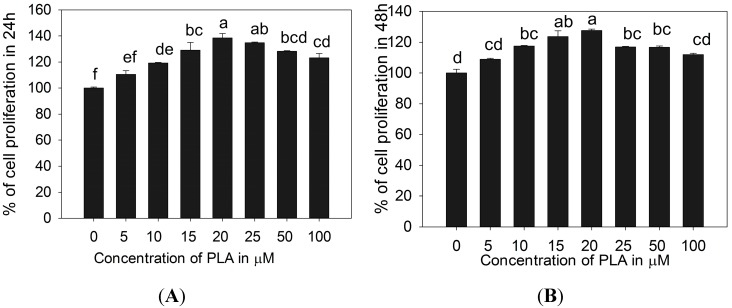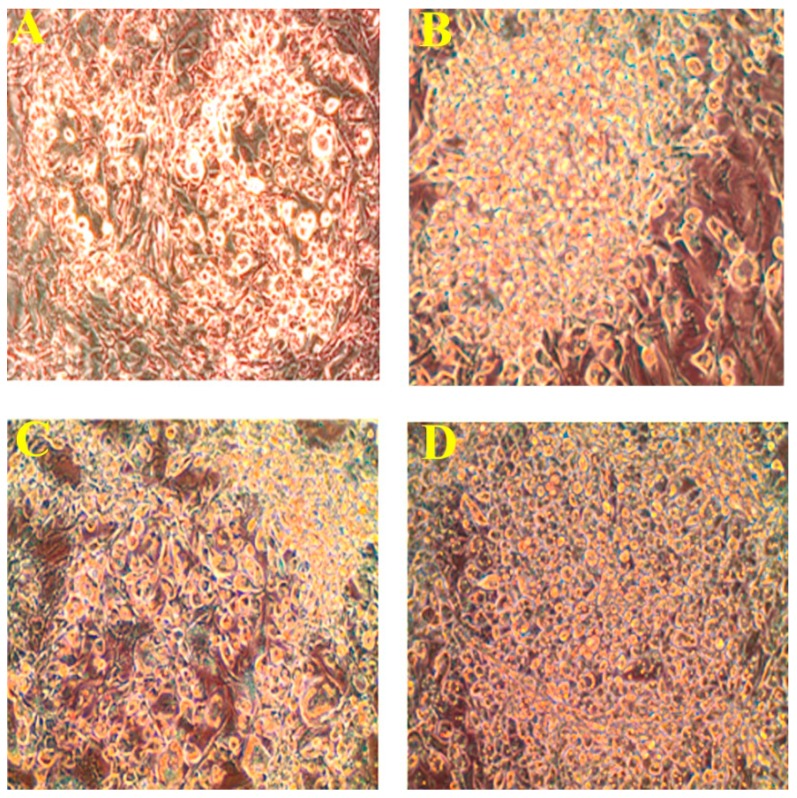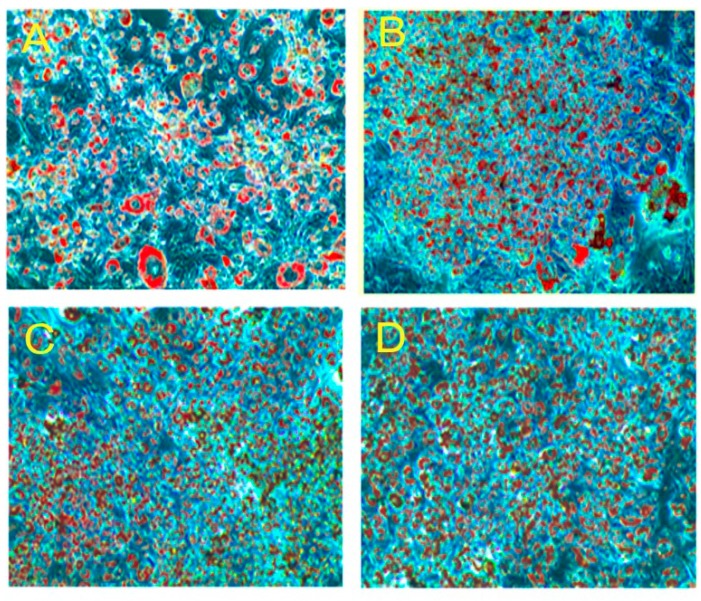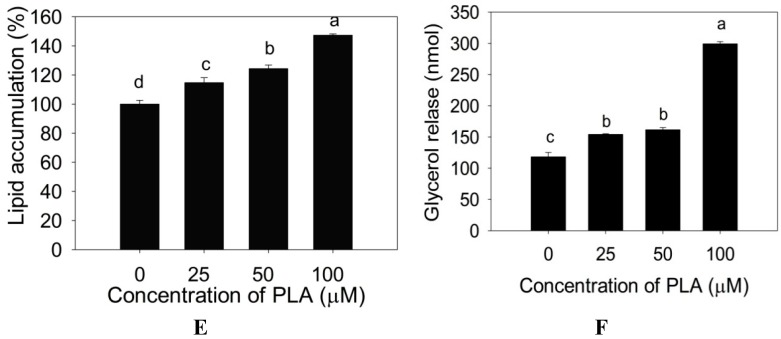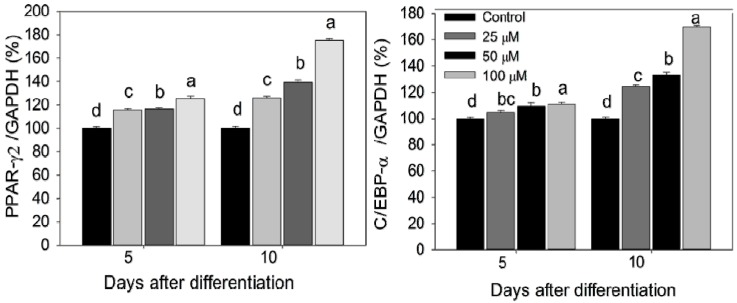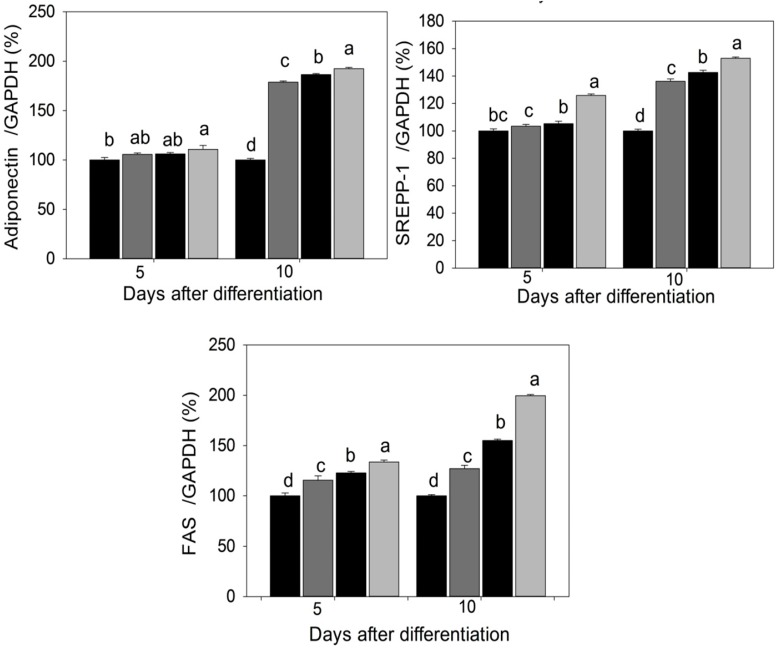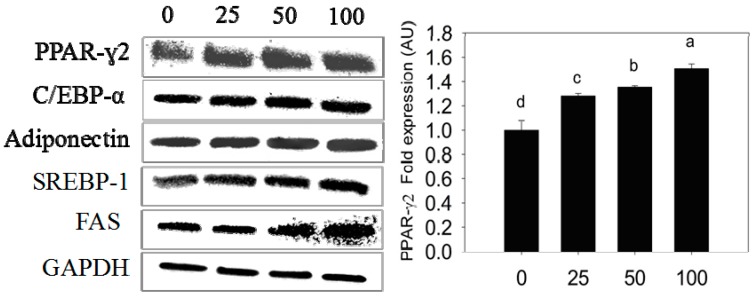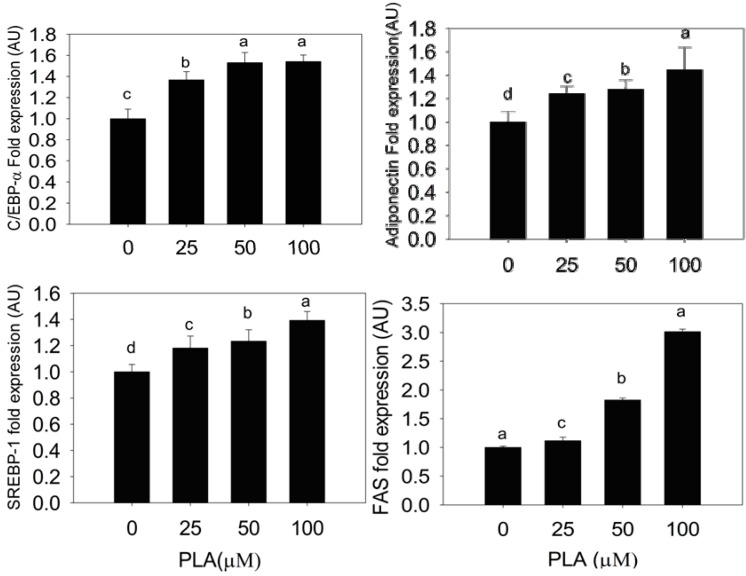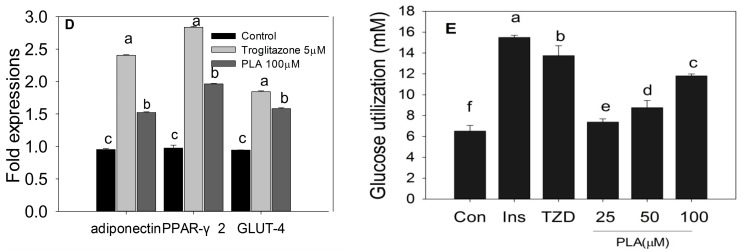Abstract
Synthetic drugs are commonly used to cure various human ailments at present. However, the uses of synthetic drugs are strictly regulated because of their adverse effects. Thus, naturally occurring molecules may be more suitable for curing disease without unfavorable effects. Therefore, we investigated phenyllactic acid (PLA) from Lactobacillus plantarum with respect to its effects on adipogenic genes and their protein expression in 3T3-L1 pre-adipocytes by qPCR and western blot techniques. PLA enhanced differentiation and lipid accumulation in 3T3-L1 cells at the concentrations of 25, 50, and 100 μM. Maximum differentiation and lipid accumulation were observed at a concentration of 100 μM of PLA, as compared with control adipocytes (p < 0.05). The mRNA and protein expression of PPAR-γ2, C/EBP-α, adiponectin, fatty acid synthase (FAS), and SREBP-1 were increased by PLA treatment as compared with control adipocytes (p < 0.05). PLA stimulates PPAR-γ mRNA expression in a concentration dependent manner, but this expression was lesser than agonist (2.83 ± 0.014 fold) of PPAR-γ2. Moreover, PLA supplementation enhances glucose uptake in 3T3-L1 pre-adipocytes (11.81 ± 0.17 mM) compared to control adipocytes, but this glucose uptake was lesser than that induced by troglitazone (13.75 ± 0.95 mM) and insulin treatment (15.49 ± 0.20 mM). Hence, we conclude that PLA treatment enhances adipocyte differentiation and glucose uptake via activation of PPAR-γ2, and PLA may thus be the potential candidate for preventing Type 2 Diabetes Mellitus (T2DM).
Keywords: phenyllactic acid, 3T3-L1 pre-adipocyte, adipocyte differentiation, troglitazone, PPAR-γ antagonist, glucose uptake, type-2 diabetes
1. Introduction
Adipose tissue is a metabolic and endocrine organ that plays an important role in the regulation of energy homeostasis. Adipocytes are potential therapeutic target for obesity, type-2 diabetes (T2DM) related diseases or disorder. Adipogenesis is a sequential process accompanied by coordinated changes in morphology, hormone sensitivity, and gene expressions. Peroxisome proliferator activated receptor-2 (PPAR-γ2), CCAAT/enhancer-binding protein-α (C/EBP-α), sterol regulatory element binding protein-1 (SREBP-1) adipocyte binding protein-2 (aP2), and FAS play important roles in regulation of adipogenesis [1].
Many studies have reported that a decrease in adipogenesis and its related gene expression are associated with T2DM [2]. Type-2 diabetes is characterized by insulin resistance and impaired insulin secretion. Insulin resistance is a condition in which muscle and adipose tissues lose their glucose uptake ability. This condition stimulates the secretion of higher amounts of insulin from pancreases. It causes high plasma insulin and glucose level, which leads to type-2 diabetes (T2DM) [3]. When adipose tissue fails to store the excessive energy as a triglyceride and it accumulated in the other than adipose tissue is called as ectopic fat, which may cause insulin resistance and insufficient insulin secretion in the pancreas [4]. Irregular adipogenesis leads to increases in plasma free fatty acid levels, which are normally stored in liver and muscle; this can stimulate insulin resistance and promote T2DM [5]. Adiponectin plays an important role in the regulation of glucose and lipid metabolism. In differentiated adipocyte, adiponectin over-expressing cells exhibited more fat accumulation, and it stimulate glucose uptake through activation of glucose transporter-4 (GLUT-4). PPAR-γ2 well know key transcriptional factor for activating many adipocyte-specific genes, and it is required for adiponectin expression [6].
Phenyllactic acid (PLA) is found in Lactobacillus spp. and produced during phenylalanine metabolism. These bacteria are commonly used in dairy, meat, and plant fermentation and also in food products like yogurt, cheese, kimchi, sauerkraut, sourdough, and pickles and it possessing potent antifungal, antioxidant and probiotic activities [7,8]. These bacteria provide certain tastes and flavors depending on the balance between volatile and non-volatile organic acids. PLA possesses a broad spectrum of antibacterial and antifungal activity [9]. Nowadays, a number of synthetic compounds are available in the market. These compounds are used as adipogenesis regulators, however, they have a number of adverse effects, therefore, isolation of new adipogenic regulator from natural sources plays an essential role in developing new therapeutic agents. For that purpose, we isolated and characterized PLA from Lactobacillus spp. [10] and planned to evaluate whether PLA can exert modulatory effects on adipocyte differentiation and lipid accumulation in 3T3-L1 pre-adipocytes.
2. Results and Discussion
2.1. 3T3-L1 Preadipocytes Proliferation Activity of PLA
Cell proliferation activity of PLA on 3T3-L1 pre-adipocytes was investigated using EZ-Cytox kit. PLA treatments (5, 10, 15, 20, 25, 50, and 100 µM) slightly influenced positive cell proliferation up to 20 µM. The further increment of PLA (25–100 µM) slightly reduced the cell proliferation after 24 and 48 h as compared with the previous dose of PLA. However, cells treated with PLA (25–100 µM) showed slight increases in cell proliferation compared with control (Figure 1).
Figure 1.
Cell proliferation activity of PLA. It increased cell proliferation in a concentration-dependent manner (5–20 μM) at 24 (A) and 48 h (B). Further increasing PLA from 25 to 100 μM reduced the % of cell proliferation, as compared with the previous concentration. The results represent the mean ± SEM of six replicates. Different letters a, b, c, d, e, f within a treatment indicate significant differences (p < 0.05).
2.2. Effect of PLA on Lipid Accumulation and Glycerol Release
Further, we investigated the effect of different concentration of PLA (5, 10, 15, 20, 25, 50 and 100 µM) on adipocyte differentiation. We found that the adipocyte differentiation was accelerated by PLA supplement at the concentration of 25–100 µM. The previous concentration of (5–20 µM) PLA did not influence adipocyte differentiation as compared to control cells. Adipocyte differentiation increased after 25 µM of PLA treatment compared with the control cells (Figure 2).
Figure 2.
Microscopic (magnifications ×20) view of adipocyte differentiation on the 10th day. (A) Control; (B) 25 µM; (C) 50 µM; (D) 100 µM. Below 25 µM did not influence adipocyte differentiation.
Figure 3A–D lipid accumulation and glycerol release in the 3T3-L1 pre-adipocytes. PLA treated adipocytes exhibited a higher number of lipid droplets than the control. The percentage of lipid accumulation was greater in the adipocyte treated with different concentration of PLA when compared with control cells (p < 0.05) (Figure 3E). Glycerol release increased remarkably in differentiated adipocytes in the presence of PLA (Figure 3F). Hence, the PLA concentration at 100 µM showed the most efficient effect on adipocyte differentiation and lipid accumulation.
Figure 3.
Oil Red O staining of lipid accumulation and glycerol release in adipocyte on the 10th day. (A) Control; (B) 25 µM; (C) 50 µM; (D) 100 µM; (E) % of lipid extracted from experimental adipocyte with 100% isopropyl alcohol; (F) Glycerol release from differentiated adipocytes in presence of different concentration of PLA. The results represent the mean ± SEM of six replicates. Different letters a, b, c, d within treatment indicate significant differences (p < 0.05).
2.3. Quantification of Adipogenic mRNA and Their Proteins by qPCR and Western Blot
The PPARγ2, C/EBP-α, adiponectin, FAS, and SREBP-1 mRNA and their protein expressions were investigated in control and experimental adipocytes by qPCR and western blot techniques. The 3T3-L1 pre-adipocytes treated with different concentrations of PLA accelerates the expression rate of PPARγ2 and C/EBP-α mRNA and their proteins compared with control cells. Subsequently, the expression of adiponectin, FAS, and SREBP-1 were stimulated in a dose-dependent manner. Maximum mRNA and their protein expressions were observed at 100 µM of PLA (Figure 4 and Figure 5).
Figure 4.
PPAR-γ2, C/EBP-α, adiponectin, SREBP-1 and FAS mRNA expression pattern in differentiated adipocytes were analyzed by qPCR. Data were shown as means ± SEM of six replicates. Different letters a, b, c, d within a treatment indicate a significant difference (p < 0.05).
Figure 5.
Immunoblot analyses of PPAR-γ2, C/EBP-α, adiponectin, SREBP-1, and FAS. Bar diagram indicates fold expression of proteins (arbitrary units-AU) in differentiated adipocytes quantified by the Imagej software. Data were shown as means ± SEM of three replicates. Different letters a, b, c, d within a treatment indicate a significant difference (p < 0.05).
The 3T3-L1 pre-adipocytes treated with troglitazone as an agonist for PPAR-γ2, (5 µM) for 48 h showed significantly increased adiponectin, PPAR-γ2, and GLUT-4 mRNA expression, compared with control cells. Similarly, we found increased expression of PPAR-γ2, adiponectin, and GLUT-4 mRNA in PLA-treated adipocytes, but these expressions were lower than with troglitazone treatment. Furthermore, PLA significantly enhanced glucose uptake in a concentration-dependent manner, these results are comparable with insulin and troglitazone treatments (Figure 6).
Figure 6.
Effect of troglitazone and PLA on lipid accumulation and glucose utilization. (A) Lipid accumulation in control; (B) Lipid accumulation in troglitazone-treated cells (5 μM); (C) Lipid accumulation in the PLA-treated cell (100 μM); (D) adipocyte treated with troglitazone (5 μM) and PLA (100 μM) increased adiponectin, PPAR-γ2 and GLUT-4 expression in adipocytes; (E) Glucose utilization in 3T3-L1 cells by troglitazone (TZD), Ins- insulin, and different concentration of PLA. Data were shown as means ± SEM of six replicates. Different letters a, b, c, d, e, f within treatments indicate significant differences (p < 0.05).
2.4. Discussion
Adipogenesis is driven by a complex transcriptional cascade pathway involving the continuous activation of PPAR-γ2 and C/EBP-α. C/EBP-α and C/EBP-γ were rapidly expressed after the hormonal induction of differentiation. These factors act synergistically to stimulate the PPAR-γ2 and C/EBP-α expression. This is a master adipogenic transcriptional factor. PPAR-γ2 and C/EBP-α together stimulate the adipocyte differentiation via activating the transcription of the genes that involved in creating and maintaining adipocyte phenotype. Many studies reported that the PPAR-γ is necessary as well as sufficient to promote adipogenesis, and the C/EBP-α is influenced by the maintaining the expression of PPAR-γ2 [11]. The present study, supplement of PLA to the 3T3-L1 preadipocytes during the adipocyte differentiation increases expression of PPAR-γ2 and C/EBP-α mRNA and their protein level. These data suggest that PLA stimulate the adipogenesis via up- regulation of PPAR-γ2 and C/EBP-α.
Adiponectin is an adipocyte-derived hormone that is expressed in differentiated adipocytes. It stimulates lipid accumulation and insulin-responsive transporter [12]. Over-expression of adiponectin in stably transduced 3T3-L1 adipocyte that stimulates adipocyte differentiation by its autocrine effects [13]. Our study indicated that the PLA enhances the adiponectin expression in differentiated adipocytes. It indicated that the PLA strongly induce the adipocyte differentiation by adiponectin secretion. Adiponectin gene transcription is induced by PPAR-γ through a PPRE in its promoter [14] and by C/EBP through an intronic enhancer [15]. Here we found that PLA enhances adiponectin in differentiated adipocytes on the 5th and 10th day might be due to PPAR-γ2 and C/EBP expression. Adiponectin promotes cell proliferation and differentiation in 3T3-L1 pre-adipocyte and augments programmed gene expression, which is responsible for adipogenesis and increasing cytoplasmic accumulation and insulin responsiveness of the glucose transport system in the adipocyte [13]. Increases of adiponectin secretion would have more favorable effects against insulin resistance as well as the atherogenic and inflammatory process [16,17]. Based on these results, pre-adipocyte exposed to PLA not only increased lipid droplet and glycerol accumulation, but also increased adiponectin mRNA, protein level and glucose utilization during differentiation.
The expression of SREBP-1 is increased in liver, white and brown adipocytes. However, higher expression of SREBP-1 is found in adipocytes as compared with other fibroblasts. It is expressed during the adipocyte differentiation [18]. SREBP-1 enhances other factors such as FAS, and acetyl carboxylase [17], glycerol-3-phosphate acyltransferase [19] and lipoprotein lipase [20]. Further, it promotes synthesis of natural fatty acid through fatty acid metabolism. SREBP-1 regulates adipocyte differentiation under the control of the PPARγ2 transcription factor [21]. Our study, SREBP-1 mRNA, and their protein expression were increased in differentiated adipocytes after differentiation induction. Further, this SREBP-1 expression was accelerated by different concentration of PLA treatments. This data suggest that the PLA significantly activate the adipocyte differentiation by activating SREBP-1 through PPARγ2 stimulation. The ADD-1/SREBP-1c plays an important role in the regulation of adipogenic gene expression by up-regulating lipogenesis and down-regulating fatty acid oxidation [22,23,24].
Fatty acid synthase (FAS) is an important enzyme in fatty acid metabolism, and it catalyzes the de novo synthesis of long-chain fatty acids from acetyl CoA and malonyl CoA via an NADPH-dependent reaction [25]. ADD-1/SREBP can stimulate FAS, and lipoprotein lipase, which are key regulators of fatty acid metabolism. Fat cells have the ability to synthesize triglycerides from fatty acids, which are provided by circulating lipoproteins or through endogenous fatty acid biosynthesis [26]. The ADD-1/SREBP regulates fatty acid metabolism via PPARγ2 activation and also induces FAS and S14 gene promoters [18,27,28]. According to qPCR and western blot results, the increases of FAS mRNA and their protein expression were associated with PLA induced lipid accumulation in adipocytes. From that we suggest that PLA stimulates adipogenesis by activating adipogenic specific genes such as PPAR-γ and C/EBP-α, plays a key regulatory role.
Thiazolidinediones (TZDs) as activators of PPAR-γ2 are the first line of agents that directly target the adipocytes. TZDs improve the insulin sensitivity by decreasing peripheral insulin resistance and thus lower blood glucose level in type-2 diabetes patients. TZDs stimulate adipocyte differentiation via increasing the number of the small adipocytes. Small adipocytes are more sensitive to insulin than large adipocytes [29,30]. PPAR-γ activation leads to stimulated glucose uptake, storage of triglycerides and production of adiponectin. It also induces increased GLUT-4 mRNA levels in adipocytes [31]. Muscle and adipose tissue contain at least two kinds of glucose transporter, GLUT-1 and GLUT-4, among which GLUT-4 is an important insulin regulator [32]. Insulin induces glucose uptake in adipocytes by binding to its receptor proteins within cells, leading to the translocation of GLUT4 to the cell surface [33]. In our results, 3T3-L1 pre-adipocytes exposed to troglitazone showed increased adiponectin, PPAR-γ2, and GLUT-4 expression during differentiation and enhanced glucose uptake in adipocytes. PLA-treated adipocytes also exhibited increased adiponectin, PPAR-γ2, GLUT-4 mRNA expression and glucose uptake. Adiponectin increases insulin sensitivity by stimulating the fatty acid oxidation, reduces triglycerides, and improves the glucose metabolism [34]. Taken together, the statements above suggest that PLA-enhanced glucose uptake in cells may be due to up-regulation of adiponectin, PPAR-γ2, and GLUT-4 mRNA levels.
3. Experimental Section
3.1. Chemicals
The mouse 3T3-L1 pre-adipocyte cell line was obtained from ATCC (CL-173, Manassas, VA, USA). The fetal bovine serum (FBS) and Dulbecco’s modified Eagle’s medium (DMEM) were from Gibco-BRL (Grand Island, NY, USA). The mRNA extraction and RT-PCR kits were from Invitrogen (Carlsbad, CA, USA). Troglitazone was from Sigma Aldrich (St. Louis, MO, USA) and T0070907, a PPAR-γ2 antagonist, was from Selleckchem (Houston, TX, USA). Primers were from Bioneer Corp. (Daejeon, Korea) and other chemicals were from Sigma (St. Louis, MO, USA) or SPL Life Sciences (Pochun, Korea).
3.2. Isolation and Characterization of PLA from Lactobacillus spp. KCC-10
Fresh Lactobacillus spp. KCC-10 was cultured in a 5 L Erlenmeyer flask containing 3 L MRS broth with 2% glucose for 3 days at 30 °C. At the end of the fermentation cycle, the supernatant was collected by centrifugation at 10,000 g for 30 min. The supernatant was extracted with ethyl acetate (3 × 300 mL). The solvent phase was concentrated using a vacuum at 35 °C to obtain the crude extract. The ethyl acetate extract was purified with a combined hexane/ethyl acetate solvent system. The isolated compound was subjected into FTIR, 1H-NMR (300 MHz) and 13C-NMR (75.45 MHz) for identification and characterization of the isolated compound. These data were already published [10].
3.3. Cell Proliferation
The water-soluble tetrazolium salt WST [2[2-methoxy-4-nitrophenyl]-3[4-nitrophenyl]-5-[2,4-disulfophenyl]-2-H-tetrazolium monosodium salt] was used for analysis of the viability of 3T3-L1 pre-adipocytes. The cells were seeded in the 96 well at a density of 1 × 104 cells/well. The cells were exposed to the different concentration of PLA. It was incubated at the 37 °C in 5% CO2 incubator for 24 and 48 h, and then the culture was treated with WST incubated for 2 h. Then, the intensity of colour was measured at 450 nm using spectra count ELISA reader (Packard Instrument Co., Downers Grove, IL, USA).
3.4. Differentiation
Adipocyte differentiation was induced according to the method of Choi et al. with modifications [35]. Briefly, 3T3-L1 pre-adipocytes were seeded in 12 well culture plats at a density of 2 × 104 cells/well. Cells were incubated at 37 °C with 5% CO2, and culture medium was replaced by every 48 h. After two days of 100% confluence of 3T3-L1 cells, the growth media was replaced by differentiation media (DMEM containing 10% FBS, 0.5 mM 3-isobutyl-1-methylxanthine, 1 μM dexamethosone, and 1.7 μM insulin) for 48 h. The pre-adipocytes were maintained and re-fed every day with 10% FBS-DMEM medium. To examine the effect of PLA on adipocytes differentiation, the pre-adipocytes received 5, 10, 15, 20, 25, 50 and 100 µM) every 2 days started at 2 days post confluence until the end of the experiment days. Troglitazone used as an agonist for PPAR-γ2.
3.5. Oil Red O Staining
Differentiated adipocytes in the presence of PLA were fixed in 10% formalin for 1 h and then washed twice with 60% isopropanol. The fixed cells were stained with 0.35% oil Red O for 10 min at 37 °C and washed twice with d-H2O [36]. Photographs were taken with an inverted microscope (CKX41, Olympus Corp., Tokyo, Japan). The oil red O stain was extracted from adipocytes with 100% isopropanol and read at 490 nm.
3.6. Measurement of Glycerol Accumulation
According to adipolysis assay Kit procedure (EMD Millipore Corporation, Billerica, MA, USA), the glycerol level was quantified. In detail, differentiated adipocytes in the presence of different concentration of PLA (25, 50 and 100 μM) were washed twice with PBS and further incubated with lipolysis buffer for 1 h. Then, the buffer was collected and measured the glycerol concentration using microplate reader at 540 nm. The amount of glycerol was calculated using a standard curve of glycerol.
3.7. Glucose Utilization Test
The glucose uptake assay was conducted by the method of Vishwanath et al. with slight modifications [37]. The differentiated adipocytes were exposed to high glucose (25 mM) containing DMEM medium with PLA (25, 50 and 100 μM), insulin (1 μg/mL) and troglitazone (5 μM), individually for 24 h. An assay, without PLA was considered as control (0). After 24 h, the concentration of glucose in spent medium was estimated with a commercial assay kit (Sigma Aldrich-GAGO-20).
3.8. Quantification of PPRA-γ, C/EBP-α, Adiponectin, SREBP-1, FAS, and GLUT-4 mRNA Expression
Total RNA was extracted and quantified with the RNeasy lipid tissue mini kit (Qiagen, Germantown, MD, USA) and UVS-99. One microgram of RNA was reverse-transcribed using oligo(dT) and reverse transcriptase (Superscript III first-stand synthesis system for RT-PCR, Invitrogen). Real-time PCR was carried out with an ABI 7500 Real-Time PCR System. Target gene expression level was determined by SYBR green-based real-time PCR in 10-µL reactions containing 5 µL Power SYBR Green Master Mix (Applied Biosystems, Foster City, CA, USA), 1 µL cDNA, 1 µL 10 pmole forward (FP) and reverse primers (RP) and 3 µL DEPC water. Primer details (PPRAγ2-FP: gtgctccagaagatgacagac, RP: ggtgggactttcctgctaa, C/EBP-α-FP: gcaggaggaagatacaggaag, RP: acagactcaaatcccaaca, adiponectin-FP: ccgttctcttcacctacgac, RP: tccccatccccatacac, FAS-FP: cccagcccataagagttaca, RP: atcgggaagtcagcacaa, SREBP-1-FP: gaagtggtggagagacgcttac (F) RP: tatcctcaaagggctggactg, GLUT-4 FP: cccacagaaggtgattgaac, RP: gagagagcccagagcgtag and G3PDH-FP: cggtgctgagtatgtctgtg, RP: ggtggagatgatgacccttt).
3.9. Western Blot
Proteins were extracted from differentiated adipocytes using RIPA lysis buffer with 1× protease inhibitor cocktail (Roche, Basel, Switzerland). The samples were centrifuged at 8000 g for 10 min at 4 °C. The total protein concentration was measured by a Bio-Rad protein assay kit. An equal amount of protein samples were separated by SDS-PAGE (10%) and transblotted onto polyvinylidene difluoride (PVDF) membranes (iBlot gel transfer stacks, Novex, Life Technology, Waltham, MA, USA). According to western breeze chemilumeniscence protocol (Invitrogen), the immunobloting was performed (except primary antibody incubation time and temperature) with rabbit monoclonal antibody of specific proteins such as PPRAγ2, C/EBP-α, and adiponectin, FAS, SREBP-1 and GAPDH. (Cell Signaling Technology, Danvers, MA, USA). The signals were observed with an enhanced chemilumeniscence kit (Bio-Rad-USA) by a chemiluminescence imaging system (Davinch Chemi, Seoul, Korea) and the intensity of immune reacted bands was quantified by the ImageJ software (1.49 version(32 bit), Wayne Rasband, National Institute of Health, Bethesda, MD, USA).
3.10. Statistical Analysis
Data were obtained from six replicates and analyses were carried out with MS Excel and the SPSS software (ver. 16; SPSS Inc., Chicago, IL, USA). Results were presented as means ± standard error. Differences between the means were analyzed using multivariate analysis with a significant level of p < 0.05.
4. Conclusions
Our data revealed that PLA supplementation accelerates adipocyte differentiation and lipid accumulation in 3T3-L1 pre-adipocytes through activation of PPAR-γ2 and the associated genes responsible for adipogenesis. Further, it stimulates the glucose uptake in the 3T3-L1 pre-adipocytes. Therefore, we suggested that the present form of the identified molecule may be a potential candidate for preventing T2DM.
Acknowledgments
This work was carried out with the support of “Cooperative Research Program for Agriculture Science & Technology Development (Project title: Technical development to increase the utilization of Italian ryegrass in livestock; Project No. PJ0109032015)” Rural Development Administration, Korea. This study was supported by Postdoctoral Fellowship Program of (National Institute of Animal Science), Rural Development Administration, and Republic of Korea.
Author Contributions
S.I., D.H.M., M.V.A., K.C.C. designed and performed experiments; R.S. and S.S. edited the manuscript. All authors have been read and approved the final version of this manuscript.
Conflicts of Interest
The authors have no conflict of interest.
Footnotes
Sample Availability: Samples of the compounds are available from the authors.
References
- 1.White U.A., Stephens J.M. Transcriptional factors that promote formation of white adipose tissue. Mol. Cell. Endocrinol. 2009;318:10–14. doi: 10.1016/j.mce.2009.08.023. [DOI] [PMC free article] [PubMed] [Google Scholar]
- 2.Dubois S.G., Heilbronn L.K., Smith S.R., Albu J.B., Kelley D.E., Ravussin E. Decreased expression of adipogenic genes in obese subjects with type 2 diabetes. Obesity. 2006;14:1543–1552. doi: 10.1038/oby.2006.178. [DOI] [PMC free article] [PubMed] [Google Scholar]
- 3.Hsieh C.W., Desantis O., Croniger C.M. Role of Triglyceride/Fatty Acid cycle in development of type-2 diabetes. In: Croniger C., editor. Endocrinology and Metabolism. Case Western Reserve University; Cleveland, OH, USA: 2011. [Google Scholar]
- 4.Sun K., Kusminski C.M., Scherer P.E. Adipose tissue remodeling and obesity. J. Clin. Investig. 2011;12:2094–2101. doi: 10.1172/JCI45887. [DOI] [PMC free article] [PubMed] [Google Scholar]
- 5.Bays H.E., Gonzalez-Campoy J.M., Bray G.A., Kitabchi A.E., Bergman D.A., Schorr A.B., Rodbard H.W., Henry R.R. Pathogenic potential of adipose tissue and metabolic consequences of adipocyte hypertrophy and increased visceral adiposity. Exp. Rev. Cardiovasc. Ther. 2008;6:343–368. doi: 10.1586/14779072.6.3.343. [DOI] [PubMed] [Google Scholar]
- 6.Karbowska J., Kochan Z. Role of adiponectin in the regulation of carbohydrate and lipid metabolism role of adiponectin in the regulation of carbohydrate and lipid metabolism. J. Physiol. Pharmacol. 2006;57:103–113. [PubMed] [Google Scholar]
- 7.Thierry A., Maillard M.B. Production of cheese flavor compounds derived from amino acid catabolism by Propionibacterium freudenreichii. Lait. 2002;82:17–32. doi: 10.1051/lait:2001002. [DOI] [Google Scholar]
- 8.Rejiniemon T.S., Raishy R., Hussain R., Rajamani B. In-vitro functional properties of Lactobacillus plantarum isolated from fermented ragi malt. South Ind. J. Biol. Sci. 2015;1:15–23. [Google Scholar]
- 9.Lavermicocca P., Valerio F.V., Visconti A. Antifungal activity of phenyllactic acid against molds isolated from bakery products. Appl. Environ. Microbiol. 2003;69:634–640. doi: 10.1128/AEM.69.1.634-640.2003. [DOI] [PMC free article] [PubMed] [Google Scholar]
- 10.Valan Arasu M., Jung M.W., Ilavenil S., Jane M., Kim D.H., Lee K.D., Park H.S., Hur T.Y., Choi G.J., Lim Y.C., et al. Isolation and characterization of antifungal compound from Lactobacillus plantarum KCC-10 from forage silage with potential beneficial properties. J. Appl. Microbiol. 2013;115:1172–1185. doi: 10.1111/jam.12319. [DOI] [PubMed] [Google Scholar]
- 11.Farmer S.R. Transcriptional control of adipocyte formation. Cell Metab. 2006;4:263–273. doi: 10.1016/j.cmet.2006.07.001. [DOI] [PMC free article] [PubMed] [Google Scholar]
- 12.Naowaboot J., Chung C.H., Pannangpetch P., Choi R., Kim B.H., Lee M.Y., Kukongviriyapan U. Mulberry leaves extract increases adiponectin in murine 3T3-L1 adipocytes. Nutr. Res. 2012;32:39–44. doi: 10.1016/j.nutres.2011.12.003. [DOI] [PubMed] [Google Scholar]
- 13.Fu Y., Luo N., Kline R.L., Garvey W.T. Adiponectin promotes adipocyte differentiation, insulin sensitivity and lipid accumulations. J. Lipid Res. 2005;46:1369–1379. doi: 10.1194/jlr.M400373-JLR200. [DOI] [PubMed] [Google Scholar]
- 14.Iwaki M., Matsuda M., Maeda N., Funahashi T., Matsuzawa Y., Makishima M., Shimomura I. Induction of adiponectin, a fat-derived antidiabetic and antiatherogenic factor, by nuclear receptors. Diabetes. 2003;52:1655–1663. doi: 10.2337/diabetes.52.7.1655. [DOI] [PubMed] [Google Scholar]
- 15.Qiao L., Maclean P.S., Schaack J., Orlicky D.J., Darimont C., Pagliassotti M., Friedman J.E., Shao J. C/EBPa regulates human adiponectin gene transcription through an intronic enhancer. Diabetes. 2005;54:1744–1754. doi: 10.2337/diabetes.54.6.1744. [DOI] [PubMed] [Google Scholar]
- 16.Kadowaki T., Yamauchi T. Adiponectin and Adiponectin Receptors. Endocr. Rev. 2005;26:439–451. doi: 10.1210/er.2005-0005. [DOI] [PubMed] [Google Scholar]
- 17.Kadowaki T., Yamauchi T., Kubota N., Hara K., Ueki K., Tobe K. Adiponectin and adiponectin receptors in insulin resistance, diabetes, and the metabolic syndrome. J. Clin. Investig. 2006;116:1784–1792. doi: 10.1172/JCI29126. [DOI] [PMC free article] [PubMed] [Google Scholar]
- 18.Tontonoz P., Kim J.B., Graves R.A., Spiegelman B.M. ADD l: A novel helix-loop-helix transcription factor associated with adipocyte determination and differentiation. Mol. Cell. Biol. 1993;13:4753–4759. doi: 10.1128/mcb.13.8.4753. [DOI] [PMC free article] [PubMed] [Google Scholar]
- 19.Kim T.S., Leahy P., Freake H.C. Promoter usage determines tissue specific responsiveness of the rat acetyl-CoA carboxylase gene. Biochem. Biophys. Res. Commun. 1996;225:647–653. doi: 10.1006/bbrc.1996.1224. [DOI] [PubMed] [Google Scholar]
- 20.Ericsson J., Jackson S.M., Kim J.B., Spiegelman B.M., Edwards P.A. Identification of glycerol-3-phosphate acyltransferase as an adipocytes determination and differentiation factor 1- and sterol regulatory element binding protein-responsive gene. J. Biol. Chem. 1997;272:7298–7305. doi: 10.1074/jbc.272.11.7298. [DOI] [PubMed] [Google Scholar]
- 21.Shimano H., Horton J.D., Hammer R.E., Shimomura I., Brown M.S., Goldstein J.L. Overproduction of cholesterol and fatty acids cause massive liver enlargement in transgenic mice expressing truncated SREBP-1a. J. Clin. Investig. 1996;98:1575–1584. doi: 10.1172/JCI118951. [DOI] [PMC free article] [PubMed] [Google Scholar]
- 22.Foretz M., Guichard C., Ferré P., Foufelle F. Sterol regulatory binding element binding protein-1c is a major mediator of insulin action on the hepatic expression of glucokinase and lipogenesis-related genes. Proc. Natl. Acad. Sci. USA. 1999;96:12737–12742. doi: 10.1073/pnas.96.22.12737. [DOI] [PMC free article] [PubMed] [Google Scholar]
- 23.Shimomura I., Bashmakov Y., Ikemoto S., Horton J.D., Brown M.S., Goldstein J.L. Insulin selectively increases SREBP-1c mRNA in the livers of rats with streptozotocin-induced diabetes. Proc. Natl. Acad. Sci. USA. 1999;96:13656–13661. doi: 10.1073/pnas.96.24.13656. [DOI] [PMC free article] [PubMed] [Google Scholar]
- 24.Florence M., Perla S., Josiane S., Takahiko M., Takuya K., Shuh N., Philippe G., Zoubir A., Raymond N., Gérard A. Arachidonic acid and prostacyclin signaling promote adipose tissue development: A human health concern? J. Lipid Res. 2003;44:271–279. doi: 10.1194/jlr.M200346-JLR200. [DOI] [PubMed] [Google Scholar]
- 25.Maier T., Leibundgut M., Ban N. The crystal structure of mammalian fatty acid synthase. Science. 2008;321:1315–1322. doi: 10.1126/science.1161269. [DOI] [PubMed] [Google Scholar]
- 26.Kim J.B., Spiegelman B.M. ADD1/SREBP1 promotes adipocyte differentiation and gene expression linked to fatty acid metabolism. Genes Dev. 1996;10:1096–1107. doi: 10.1101/gad.10.9.1096. [DOI] [PubMed] [Google Scholar]
- 27.Kim J.B., Wright H.M., Wright M., Spiegelman B.M. ADD1/SREBP1 activates PPARγ through the production of endogenous ligand. Proc. Natl. Acad. Sci. USA. 1998;95:4333–4337. doi: 10.1073/pnas.95.8.4333. [DOI] [PMC free article] [PubMed] [Google Scholar]
- 28.Kim J.B., Sarraf P., Wright M., Yao K.M., Mueller E., Solanes G., Lowell B.B., Spiegrlman B.M. Nutritional and insulin regulation of fatty acid synthetase and leptin gene expression through ADD-1/SREBP1. J. Clin. Investig. 1995;101:1–9. doi: 10.1172/JCI1411. [DOI] [PMC free article] [PubMed] [Google Scholar]
- 29.Staels B., Fruchart J.C. Therapeutic roles of peroxisome proliferator activated receptor agonists. Diabetes. 2005;54:2460–2470. doi: 10.2337/diabetes.54.8.2460. [DOI] [PubMed] [Google Scholar]
- 30.Spiegelman B.M. PPAR-gamma: Adipogenic regulator and thiazolidinedione receptor. Diabetes. 1998;47:507–514. doi: 10.2337/diabetes.47.4.507. [DOI] [PubMed] [Google Scholar]
- 31.Shintani M., Nishimura H., Yonemitsu S., Ogawa Y., Hayashi T., Hosoda K., Inoue G., Nakao K. Troglitazone Not Only Increases GLUT4 but Also Induces Its Translocation in Rat Adipocytes. Diabetes. 2001;50:2296–2300. doi: 10.2337/diabetes.50.10.2296. [DOI] [PubMed] [Google Scholar]
- 32.Fukumoto H., Kayano T., Buse J.B., Edwards Y., Pilch P.F., Bell G.I., Seino S. Cloning and characterization of the major insulin-responsive glucose transporter expressed in human skeletal muscle and other insulin-responsive tissues. J. Biol. Chem. 1989;264:7776–7779. [PubMed] [Google Scholar]
- 33.Rathi S., Grover J.K., Vats V. The effect of Momordica charantia and Mucuna pruriens in experimental diabetes and their effect on key metabolic enzymes involved in carbohydrate metabolism. Phytother. Res. 2002;16:236–243. doi: 10.1002/ptr.842. [DOI] [PubMed] [Google Scholar]
- 34.Tsao T.S., Lodish H.F., Fruebis J. ACRP30, a new hormone controlling fat and glucose metabolism. Eur. J. Pharmacol. 2002;440:213–221. doi: 10.1016/S0014-2999(02)01430-9. [DOI] [PubMed] [Google Scholar]
- 35.Choi K.C., Roh S.G., Hong Y.H., Shrestha Y.B., Hishikawa D., Chen C., Kojima M., Kangawa K., Sasaki S. The role of ghrelin and growth hormone secretagogues receptor on rat adipogenesis. Endocrinology. 2003;144:754–759. doi: 10.1210/en.2002-220783. [DOI] [PubMed] [Google Scholar]
- 36.Ilavenil S., Valan Arasu M., Lee J.C., Kim D.H., Roh S.G., Park H.S., Choi G.J., Mayakrishnan V., Choi K.C. Trigonelline attenuates the adipocyte differentiation and lipid accumulation in 3T3-L1 cells. Phytomedicine. 2014;21:758–765. doi: 10.1016/j.phymed.2013.11.007. [DOI] [PubMed] [Google Scholar]
- 37.Divya V., Harini S., Manjunath S.P., Sowmya S.S., Dixit M.N., Kakali D. Novel method to differentiate 3T3-L1 cells in vitro to produce highly sensitive adipocytes for a GLUT4 mediated glucose uptake using fluorescent glucose analog. J. Cell Commun. Signal. 2013;7:129–140. doi: 10.1007/s12079-012-0188-9. [DOI] [PMC free article] [PubMed] [Google Scholar]



